One of the very best bits of a properly cooked brisket is the fat-rich bits from the point known as “burnt ends.” The only problem with them is that there are so few really amazing bites like that on a whole brisket, and brisket is not the easiest thing to cook properly. Is there a way to capture that brain-stem tingling experience of meltingly tender meat with silky, incredible fat without having to cook a whole packer? Malcolm over at How to BBQ Right says yes there is! His recipe for pork belly burnt ends captures the fatty goodness of brisket burnt ends, but with only a fraction of the cooking time. So read on, and discover what makes a good burnt end and how you can use careful control of temperature—with your Smoke™ dual-channel thermometer— to get there.
Contents
- What are burnt ends, and can they be made of pork belly?
- Pork belly thermal principles
- Science of braising
- Recipe
What are burnt ends? Can pork even be burnt ends?
The term “burnt ends” is regionally defined, so it’s hard to pin down an exact meaning. Many people think of them as being nearly anything from the brisket point, while others accept only that bit which is left along one side after all the rest of the point has been cut up. Restaurants, anxious to maximize profits and minimize food costs, generally use any bits from a brisket that are too burnt or tough to sell with the sliced meat. Disregarding that scandalous definition, we are left with the point of the beef brisket, either in part or in total.
So what makes the point special? Fat. Brisket point is shot through with more fat than anyone actually needs in any given meal, and what isn’t fat is strung together with connective collagen. When it is cooked, both the collagen and the fat render down, creating gelatin and, well, liquid fat. Lots of the fat actually runs out of the meat, creating pillowy sections of fat tissues that have been partially drained of their contents. This makes them soft and gives then that slurpy quality that may not sound appetizing when I describe just it like that but is absolutely delicious when you taste it.
Also, it is generally recognized that burnt ends must have heavy bark on one at least one side.
Aside from the obvious lack of beef in a pork belly, every one of these criteria can easily be met in pork belly burnt ends. The belly is absolutely all about fat (pork belly is, after all, the cut from which bacon is made), and the bits that aren’t fat are tightly bound up with loads of collagen. The same low/slow cooking methods that produce incredibly tasty burnt ends will produce a similar result in pork belly. And bark is no problem. We can add bark.
Because “burnt ends” is so poorly defined, and because pork belly fits so nicely with the necessary eating experience of them, there’s no reason we can’t call these ridiculously delicious bites “pork belly burnt ends,” in much the same way we should call the originals “brisket burnt ends.”
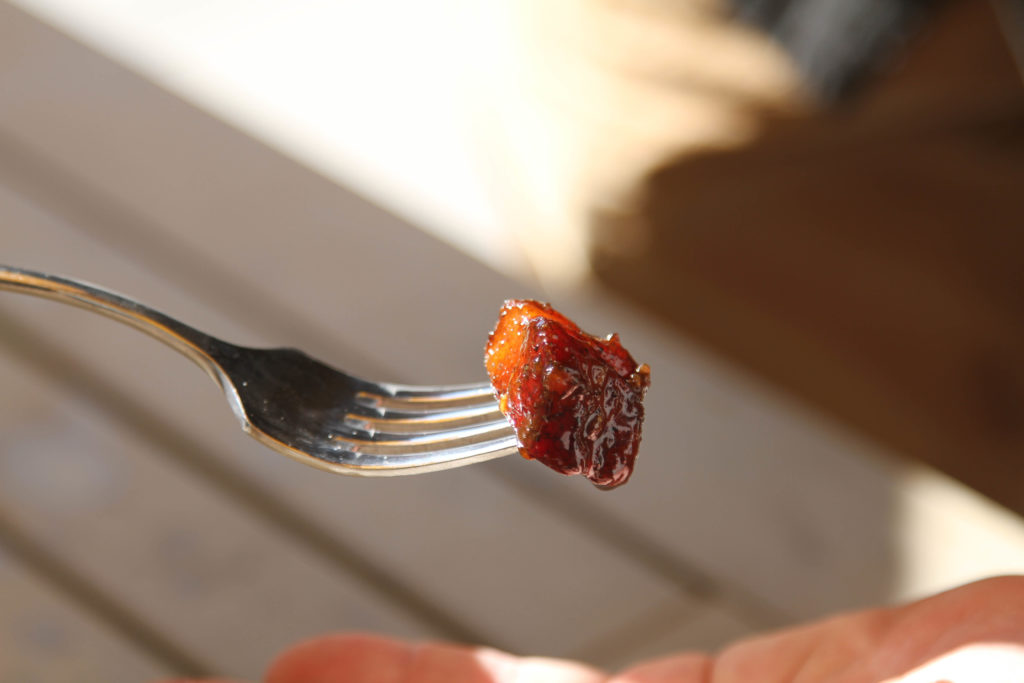
Pork belly thermal principles
To understand how pork belly can become succulent, tender burnt ends, we need to understand what happens when we cook it. As already mentioned, pork belly is high in connective tissue and fat. That’s not a recipe for steak-like cooking. To cook pork belly properly, we have to give it the time and temperatures it needs to render both the fat and the collagen. This usually means low, slow cooking. Any meat will expel its available free water at temperatures above 180°F (82°C), becoming tough and dry. But when collagen unravels, it turns into gelatin and releases water back into the meat, which the gelatin tries to hold on to. If you were to try to cook the pork belly at 450°F (232°C) to speed this up, you’d dry even that water out by the time the center of the belly had gotten to a high enough temperature. Keeping the temperature lower allows for melting of collagen without drying the meat a second time.
This slow cooking also allows some of the fat in the belly to render out. While we love the fatty goodness of both burnt ends and pork belly, no one really wants that big a mouthful of pure fat. The long cooking time gives the fat cells a chance to drain out some of their excess, providing a more manageable amount of fat in each bite.
To cook these pork belly burnt ends, we’ll first smoke them at a medium-low heat—250°F (121°C) which will render a lot of the fat and get the collagen dissolution going. We’ll monitor our smoker with a Smoke dual-channel thermometer and its accompanying air probe. Keeping an eye on the temperature of your smoker really is key to a successful burn end. If it’s too cool in your smoker, it will take too long to cook (you’re hungry now, right?), too hot and you get dried out, actually burnt ends.
But to really kick things up, we’re also going to braise them.
Science of braising
The point of braising is to provide a relatively quick and delicious medium for the dissolution of collagen into gelatin and water. How is this accomplished? The ‘delicious’ part is taken care of by a flavorful liquid bath, but what about the quickness?
Air is inefficient medium for heat transfer. It won’t cling to food and it has such a small heat capacity. Water, on the other hand, is very efficeint. Putting ribs in a pan with a water-based cooking liquid is like super-charging the heat transfer.
“Indeed, because water is such a great conductor of heat, beef boiled in 212°F water will actually get hotter…faster than beef roasted in 212°F oven!”—J. Kenji López-alt, The Food Lab, pg. 239
When trying to pump enough heat into your pork belly to get it up to 203°F (95°C), using steam and water gets you there much more quickly. The presence of the liquid allows for a faster heat transfer, and that means faster collagen dissolution. That’s why, for instance, a smoked brisket takes 16 hours or so to cook, but a braised brisket is done in only 6.
“Collagen breakdown—the conversion of tough connective tissue into soft gelatin—begins slowly at around 140°F [60°F] and increases at an exponential rate as the temperature goes up. Pork shoulder cooked at 140°F [60°F] might take 2 days to fully soften, while at 180°F, the time is cut down to a few hours.”—J. Kenji López-alt, The Food Lab, pg. 272, emphasis added
In this case, we’ll be braising slowly in fat (butter), which isn’t quite as efficient as water, but still brings a lot more heat conduction to the party. Of course, there will be steam and rendered liquid that the belly will cook in, too, creating a true braising environment as the cook progresses.
After the braising, we’ll glaze the burnt ends with some spicy/sweet BBQ sauce and serve them up! Here’s the full recipe, so cook along!
Smoked Pork Belly Burnt Ends Recipe
Based on the recipe from How to BBQ Right.
Ingredients
- 8 lb skinless pork belly (this amount takes up a lot of room on a smoker, half it if needed)
- ½ C your favorite BBQ rub
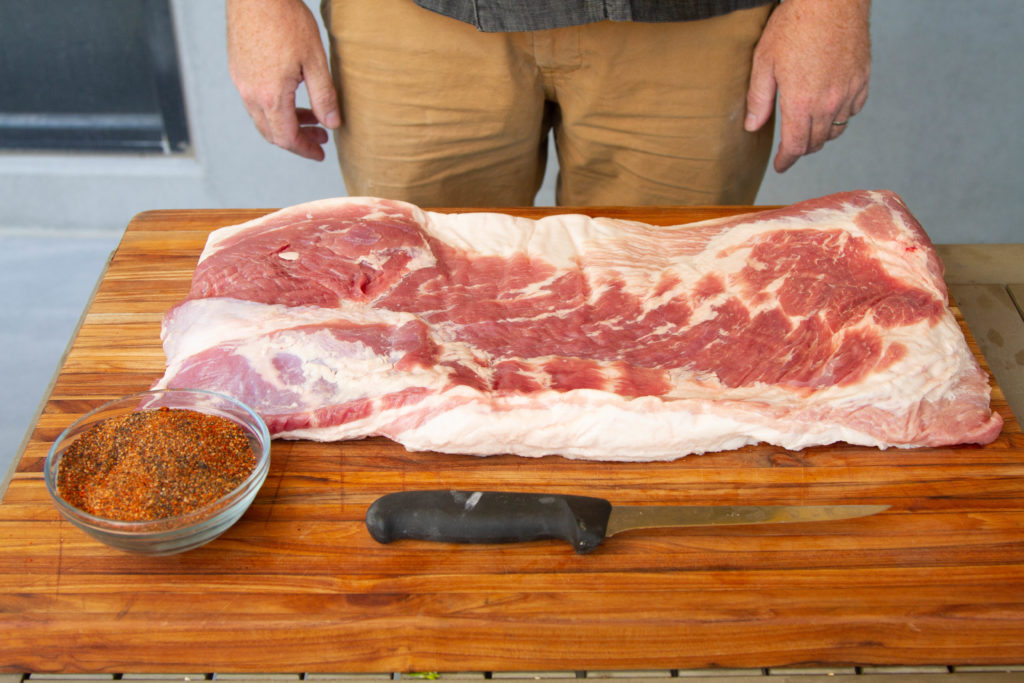
for the braise
- 1 ½ sticks butter, sliced
- ½ C brown sugar
- ¼ C honey
for the glaze
- 1 C BBQ sauce of your choice
- ¼ C apple jelly (substitute a different jelly—pepper is good—if not available)
- ¼ C apple juice
- 1 Tbsp Frank’s Red Hot sauce
Special equipment:
- Cooling racks
- Disposable aluminum pans
- Aluminum foil
Instructions
- Preheat your smoker to 250°F (121°C). Set up a Smoke thermometer to monitor the air temp, with a high alarm at 275°F (135°C) and a low alarm at 225°F (107°C).
- Cut the pork belly into squares, 1-1.5” on a side.
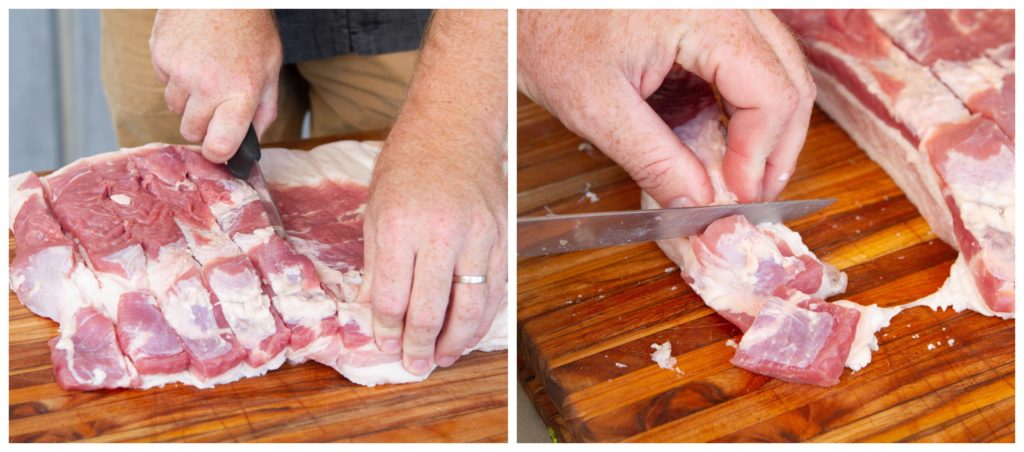
- Toss the belly pieces with the BBQ rub to coat.

- Place rib pieces on cooling racks to facilitate moving to and from the smoker. 8 pounds won’t fit on one rack. We used two racks and two smokers for this.
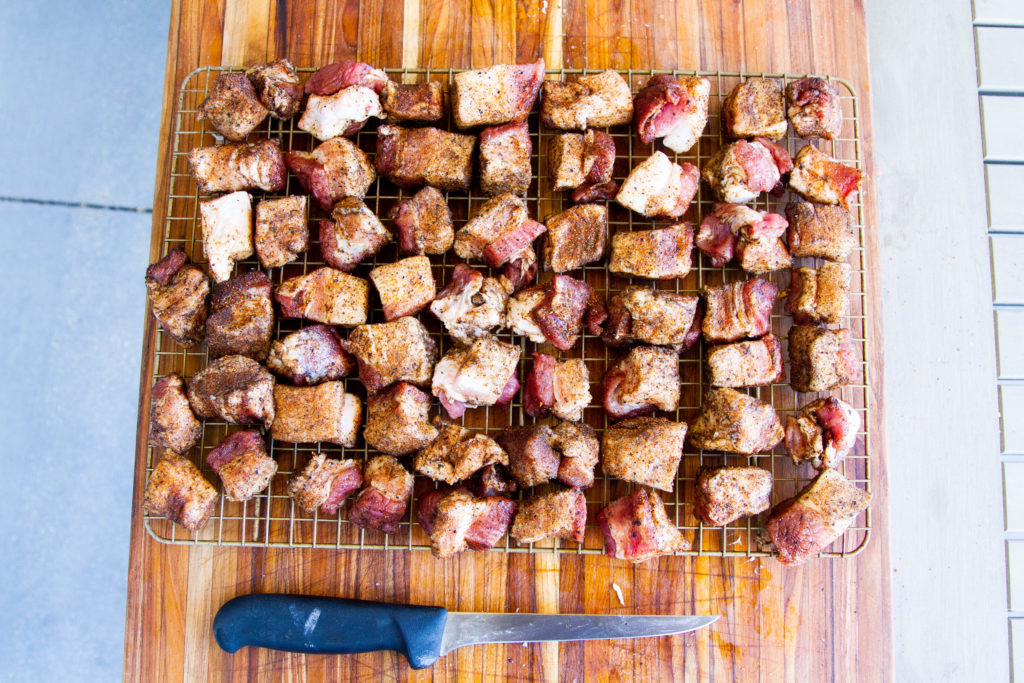
- Place in smoker and cook for 2 hours. Set air temp alarm on your smoke to regulate the temperature—high alarm at 275°F (135°C), low alarm at 225°F (107°C).

- Remove racks of belly pieces from heat. They are already delicious!
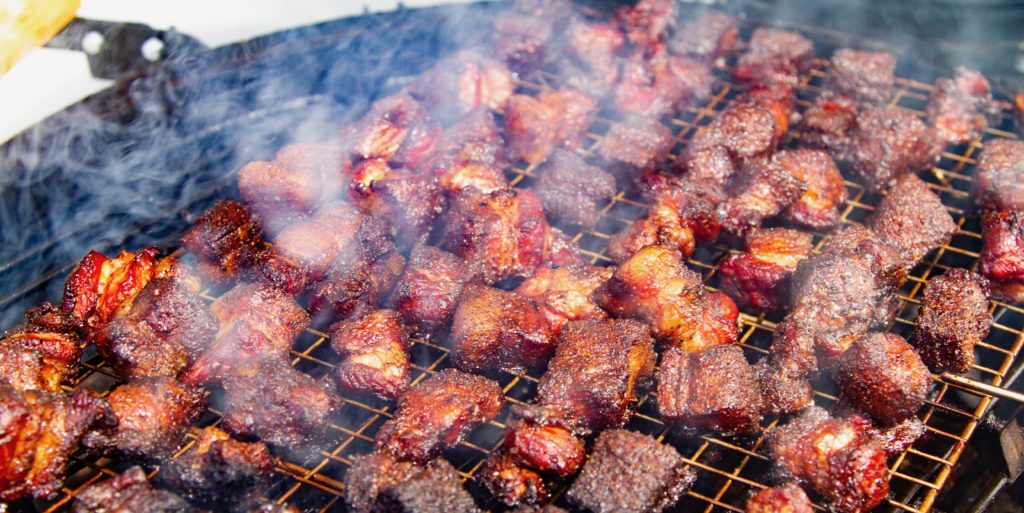
- Place pieces in an aluminum pan and add the sugar, honey, and butter.
- Insert a probe from the Smoke thermometer into a large piece of pork. Set the high-temp alarm for the pork to 203°F (95°C).
- Cover the aluminum pan tightly with foil and smoke for about an hour, until the internal temperature of the pork reaches 203°F (95°C).

- Remove the pan from heat and transfer pork pieces to a second pan. Combine ingredients for BBQ sauce and pour over burnt ends.
- Toss to coat.
- Return pan to the smoker, uncovered, for about 10 minutes to set the glaze.

- Remove from heat, pile on a plate and call your friends!
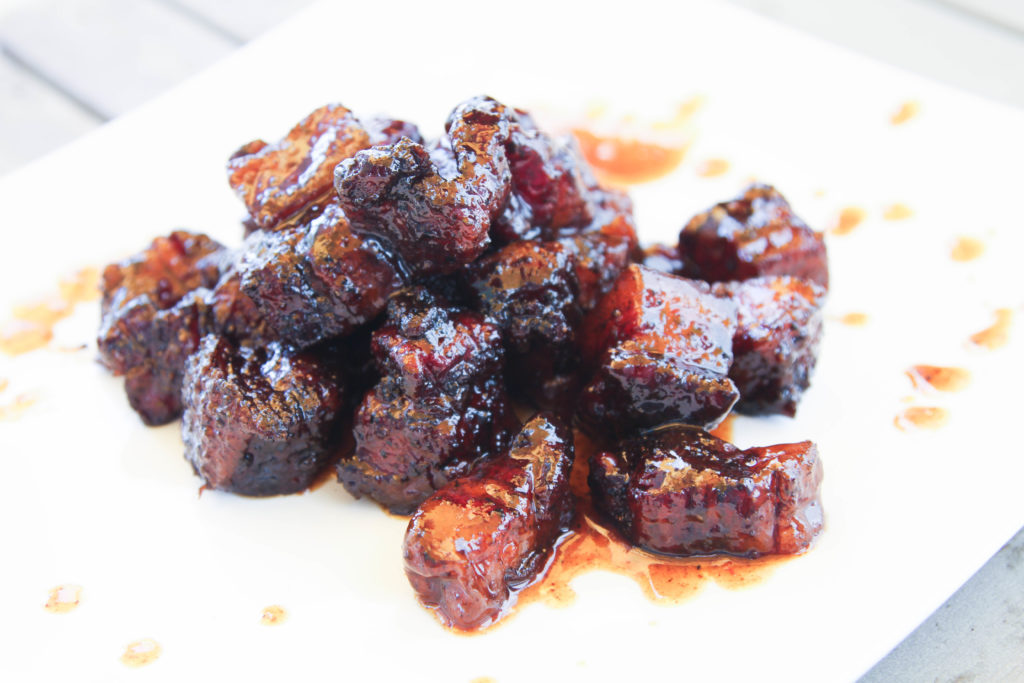
With the aid of your Smoke thermometer, you can get the kind of well-regulated heat you need to melt the collagen and fat of a pork belly into succulent, tongue-pleasing burnt ends. And with the two-channel cooking ability, you can also make sure you get them off the smoker as soon as they’re done, so you don’t have to wait a moment longer! Enjoy!
Shop now for products used in this post:
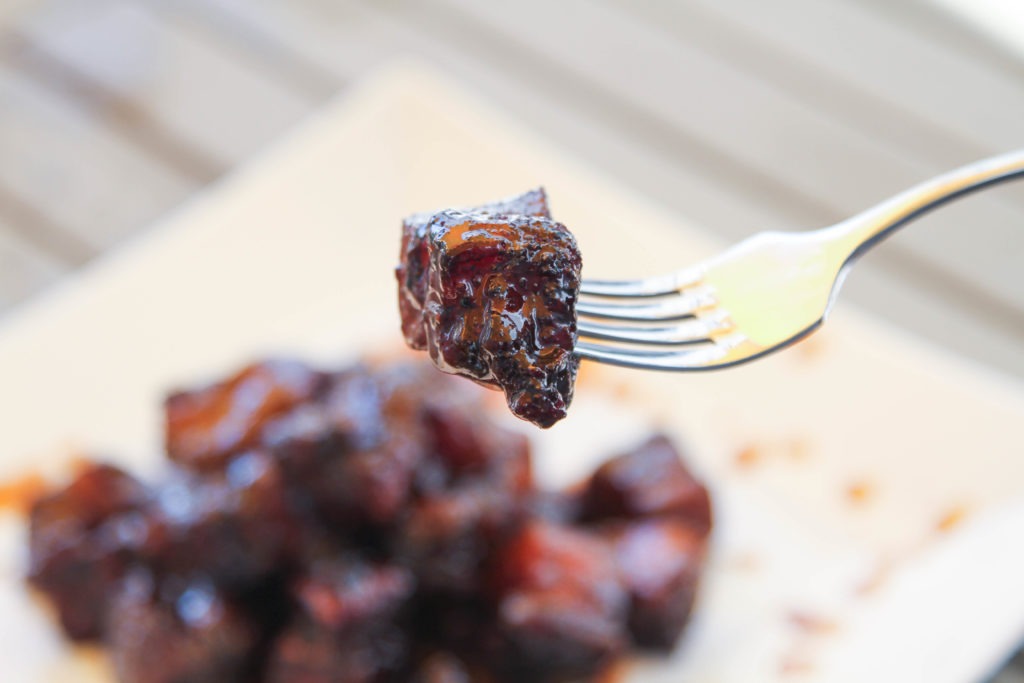




Mark J Skiba says
Talk about clogged arteries !!!!!!!!!!
Your Killing Me !!!!!!!!!
Tracy says
These sound fantastic! Can I make this on a gas grill if i don’t have a smoker?
Martin says
If you can keep the temp in the right range, yes!
Keven Entzel says
As with most of your recipes, this looks really good. The one big problem for me and a lot of other people these days is the majority of your (or anyone else’s) BBQed, smoked or grilled meat recipes, all call for tons of sugar of one sort or another. I (and a lot of others in this age of diabesity) can’t have sugar of any sort, no white, brown, turbinado or other forms of cane or beet sugar. No molasses, no honey or maple syrup. No sugar period. I’m not even allowed to eat fruit other than a few berries.
Can you convert your recipes to no sugar versions and put a section for us on your website, please?
Martin says
Keven,
I understand that this a big problem for a lot of people. In this particular case, you can leave the sugar out of the rub and just braise them in some butter, then skip the sugary glaze. Just toss them on the smoker gain to “dry out” the butter. Believe me, they’re still plenty tasty!
Mark says
I couldn’t get pork belly, so I tried chopping “country-style ribs” into cubes instead…I don’t recommend anyone else try it! ????
Martin says
Mark,
Oh no! I’m sorry it didn’t go well. Those “country-style ribs” have neither the fat nor the connective tissue to stand up to this cooking process. But thanks for taking a hit for the rest of us! I hope you can find some pork belly and give it a try. If you do, let us know how you liked it!
Bill says
Ask your butcher to order a slab of bacon “uncut” there you go, plus it will be cured, you’re welcome 😎
Paul says
Is it ok to stack two or three cooling racks at different heights in one smoker? Don’t understand why you say you used two smokers for two racks.
Martin says
Paul,
No problem! I was using a smoker that wouldn’t fit two racks deep. Go for it!
Brian says
What is the desired temp after the first 2 hours of smoking? One important thing I’ve learned on this site is temperature not time controls the process. The smoking range of 225 to 275, the size of the cut meat, and the meat temperature all play a role in the success of the smoke.
Thank you.
Martin says
Brian,
Thank you for your comment! The temp stays the same for the rest of the cook, but now the pieces are covered and smothered in sugar and butter. You are right that temp matters, so get those ends to 203°F and dig in!
MikeB says
I just made these very closely in line with the instructions here. Simply awesome!
Martin says
Mike,
Crazily addictive, aren’t they?
Jeff says
So is the butter/sugar that’s left in the first pan (with lots of pork fat certainly there too) – is that all just discarded? I’m not sure what I’d do with it anyways, but want to be sure I understand correctly.
Martin says
Jeff,
That is correct, I’m afraid.
Dallas Jass Jr says
i make my own bacon and have lots of ends and pieces left over so i thaught i would try making burnt ends with them. i will let you know how this works works out.!
thanks for the recipe!